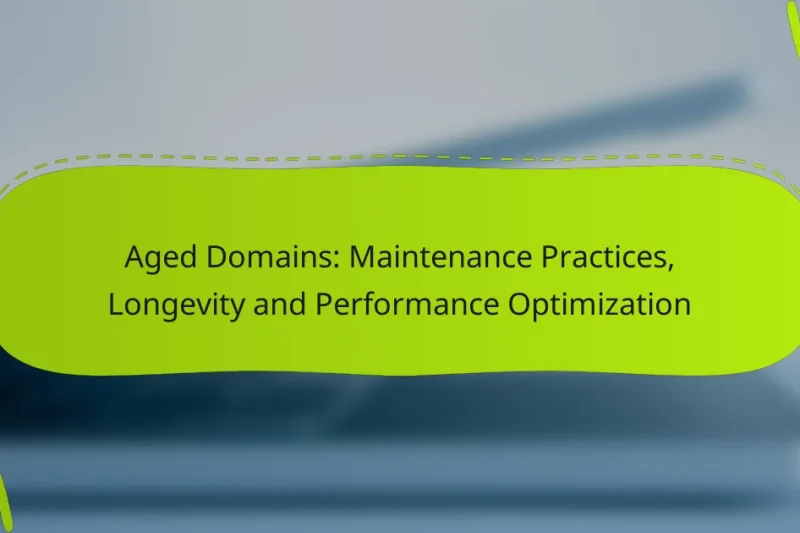Aged domains offer unique advantages for website performance, leveraging established authority and trustworthiness to enhance visibility … Aged Domains: Maintenance Practices, Longevity and Performance OptimizationRead more
Using Aged Domains for SEO Success
Aged domains offer a unique opportunity to boost SEO performance by capitalizing on their established authority and backlink history. By carefully selecting domains relevant to your niche and integrating quality content, you can enhance your website’s visibility and rankings. However, it’s essential to be aware of potential risks, such as penalties and spammy backlinks, that could undermine your efforts.
Aged Domains: Marketing Integration, Campaign Enhancement and Brand Visibility
Aged domains serve as powerful tools for enhancing marketing integration and brand visibility in Palau. By … Aged Domains: Marketing Integration, Campaign Enhancement and Brand VisibilityRead more
Aged Domains: Affiliate Marketing, Success Metrics and Traffic Generation
Aged domains offer a powerful advantage in affiliate marketing by utilizing their established authority and trust … Aged Domains: Affiliate Marketing, Success Metrics and Traffic GenerationRead more
Aged Domains: Redirect Strategies, Traffic Boost and SEO Impact
Aged domains offer a unique advantage for boosting website traffic and enhancing SEO performance through their … Aged Domains: Redirect Strategies, Traffic Boost and SEO ImpactRead more
Aged Domains: Niche Authority, Building Strategies and Trust Signals
Aged domains serve as powerful tools for enhancing niche authority by offering established credibility and trust … Aged Domains: Niche Authority, Building Strategies and Trust SignalsRead more
Aged Domains: Content Strategies, Traffic Maximization and Engagement
Aged domains present a unique opportunity for website owners to boost traffic and engagement by capitalizing … Aged Domains: Content Strategies, Traffic Maximization and EngagementRead more
Aged Domains: Local SEO, Best Practices and Ranking Benefits
Aged domains can significantly enhance local SEO by improving search visibility and credibility. Their established history … Aged Domains: Local SEO, Best Practices and Ranking BenefitsRead more
How can aged domains improve SEO in Palau?
Aged domains can significantly enhance SEO in Palau by leveraging their established reputation and authority. These domains often come with a history of backlinks and traffic, which can provide a head start in search engine rankings.
Enhanced domain authority
Aged domains typically possess higher domain authority due to their longer presence on the internet. This authority can lead to better visibility in search engine results, making it easier for businesses in Palau to attract organic traffic.
When selecting an aged domain, consider its age, previous usage, and overall reputation. Domains that have been well-maintained and free from penalties are more likely to contribute positively to your SEO efforts.
Established backlinks
One of the most valuable aspects of aged domains is their existing backlinks. These links from reputable sites can drive traffic and improve your own site’s credibility in the eyes of search engines.
To maximize the benefits of established backlinks, analyze the quality and relevance of the linking domains. Focus on domains that align with your niche or industry to ensure that the traffic you receive is targeted and beneficial.
Targeted traffic acquisition
Aged domains often come with a history of traffic, which can be advantageous for acquiring targeted visitors. This existing audience can provide immediate engagement and potential conversions for businesses in Palau.
To effectively leverage this traffic, ensure that your content aligns with the interests of the previous audience. Additionally, consider running targeted marketing campaigns to attract new visitors while retaining the existing ones.
What are the best practices for using aged domains?
To effectively use aged domains for SEO success, focus on their history, relevance to your niche, and how you integrate content. Following these best practices can enhance your website’s authority and search engine rankings.
Thorough domain history analysis
Before acquiring an aged domain, conduct a comprehensive analysis of its history. Check for past penalties, spammy backlinks, or any negative associations that could affect your SEO efforts. Tools like Ahrefs or SEMrush can help you evaluate the domain’s backlink profile and overall reputation.
Look for domains that have a clean history with minimal changes in ownership. A stable ownership history often indicates reliability and can contribute positively to your SEO strategy.
Relevance to current niche
Ensure that the aged domain is relevant to your current niche or industry. A domain that aligns closely with your business will naturally attract a more targeted audience, improving engagement and conversion rates. For example, a domain previously used for a travel blog would be more beneficial for a travel agency than one used for unrelated topics.
Consider the keywords associated with the domain. If they match your current content strategy, this can enhance your SEO performance by leveraging existing authority in those areas.
Proper content integration
When integrating content into an aged domain, maintain a balance between old and new material. Update existing content to reflect current standards and practices while adding fresh, relevant articles that align with your audience’s interests. This approach can help retain the domain’s existing traffic while attracting new visitors.
Avoid drastic changes that could confuse users or search engines. Gradually introduce new content and ensure that it complements the existing material, preserving the domain’s established authority and relevance.
What are the risks of using aged domains?
Using aged domains can pose several risks that may negatively impact your SEO efforts. These risks include potential penalties from search engines, the presence of spammy backlinks, and a loss of brand credibility.
Potential for penalties
Aged domains can carry hidden penalties from past owners, which may lead to reduced visibility in search engine results. If a domain was previously involved in black-hat SEO tactics, search engines like Google may impose penalties that affect your site’s ranking.
To mitigate this risk, conduct thorough due diligence before purchasing an aged domain. Use tools like Google Search Console and backlink analysis software to check for any existing penalties or issues.
Spammy backlinks
Many aged domains come with a history of backlinks, some of which may be low-quality or spammy. These backlinks can harm your SEO by associating your site with untrustworthy sources, potentially leading to penalties.
Evaluate the backlink profile of an aged domain using tools like Ahrefs or Moz. Aim for a domain with a clean, reputable backlink history to avoid inheriting spammy links that could damage your SEO standing.
Loss of brand credibility
Using an aged domain that has a questionable reputation can lead to a loss of brand credibility. If users associate your brand with negative past content or practices, it can deter potential customers and harm your overall reputation.
To protect your brand, choose an aged domain that aligns with your values and has a positive history. Conduct a thorough review of the domain’s past content and reputation before making a purchase to ensure it reflects well on your brand.
How to select the right aged domain?
Selecting the right aged domain involves evaluating several key factors that can impact your SEO success. Focus on domain authority, backlink profiles, and historical performance to ensure you choose a domain that will enhance your online presence.
Check domain authority metrics
Domain authority (DA) is a crucial metric that indicates how well a domain is likely to rank on search engines. Generally, a DA score ranges from 1 to 100, with higher scores suggesting greater potential for visibility. Aim for domains with a DA of at least 20 to 30 for a solid foundation.
Use tools like Moz or Ahrefs to check the DA of potential domains. Compare multiple options to identify those with the best authority scores, keeping in mind that a higher DA often correlates with better SEO performance.
Evaluate backlink profile
A strong backlink profile is essential for any aged domain. Look for domains with high-quality, relevant backlinks from reputable sources, as these can significantly influence search rankings. Tools like SEMrush or Majestic can help you analyze the backlink profile effectively.
Consider the diversity and relevance of the backlinks. A domain with a mix of backlinks from various industries may perform better than one with many links from a single source. Avoid domains with spammy or toxic backlinks, as they can harm your SEO efforts.
Assess historical performance
Understanding a domain’s historical performance can provide insights into its potential for future success. Check for any past penalties or drops in rankings, which may indicate issues that could affect your SEO strategy. Use the Wayback Machine to view the domain’s previous content and assess its relevance.
Look for consistent traffic trends over time. A domain that has maintained steady traffic is often a better choice than one with erratic performance. Additionally, consider the niche relevance of the domain to ensure it aligns with your target audience and business goals.
What tools can help in aged domain analysis?
Several tools are essential for analyzing aged domains effectively. These tools provide insights into backlinks, domain metrics, and historical content, which are crucial for evaluating the potential of an aged domain for SEO success.
Ahrefs for backlink analysis
Ahrefs is a powerful tool for examining the backlink profile of an aged domain. It allows users to see the quantity and quality of backlinks, which can indicate the domain’s authority and trustworthiness. A strong backlink profile is often a key factor in determining how well a domain can perform in search engine rankings.
When using Ahrefs, focus on metrics such as Domain Rating (DR) and the number of referring domains. A DR above 30 is generally considered good, while a higher number of unique referring domains can enhance the domain’s credibility. Look for backlinks from reputable sites to maximize SEO benefits.
SEMrush for domain metrics
SEMrush provides comprehensive domain metrics that help assess the overall health of an aged domain. Key metrics include organic traffic estimates, keyword rankings, and competitive analysis. These insights can guide your decision on whether to acquire a specific domain.
Utilize SEMrush to compare the aged domain with competitors in the same niche. Look for domains with stable or growing organic traffic and a diverse keyword portfolio. This can indicate a domain with potential for future growth and SEO success.
Wayback Machine for historical content
The Wayback Machine is invaluable for viewing the historical content of an aged domain. By examining past versions of the site, you can identify its previous purpose, content quality, and any potential penalties it may have incurred. Understanding the domain’s history can inform your strategy for its future use.
When using the Wayback Machine, check for any significant changes in content or branding over time. If the domain has a history of spammy content or has been penalized, it may not be worth pursuing. Conversely, a domain with a rich content history can provide a solid foundation for your SEO efforts.
How to integrate an aged domain into an existing site?
Integrating an aged domain into an existing site involves careful planning to leverage its established authority and traffic. Key steps include setting up 301 redirects, migrating relevant content, and ensuring a seamless user experience.
301 redirects for traffic transfer
301 redirects are crucial for transferring traffic from the aged domain to your existing site. This permanent redirect informs search engines that the content has moved, helping to preserve SEO value. Implementing these redirects can lead to a smoother transition and maintain the traffic levels you expect.
When setting up 301 redirects, prioritize pages that historically received the most traffic or had high engagement. Tools like Google Search Console can help identify these pages. Ensure that the redirects are tested thoroughly to avoid broken links, which can negatively impact user experience and SEO.
Content migration strategies
Content migration from the aged domain should focus on preserving valuable information while enhancing your current site’s offerings. Identify high-performing content that aligns with your existing site’s goals and audience. This can include blog posts, articles, or product pages that have garnered attention.
Consider creating a content audit to evaluate which pieces to migrate. Use tools to analyze metrics such as organic traffic and engagement rates. After migrating content, update internal links and optimize for current SEO practices to maximize visibility and relevance.






